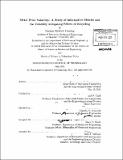| dc.contributor.advisor | Joel P. Clark. | en_US |
| dc.contributor.author | Fleming, Nathan Richard | en_US |
| dc.contributor.other | Massachusetts Institute of Technology. Technology and Policy Program. | en_US |
| dc.date.accessioned | 2011-10-17T21:31:29Z | |
| dc.date.available | 2011-10-17T21:31:29Z | |
| dc.date.copyright | 2011 | en_US |
| dc.date.issued | 2011 | en_US |
| dc.identifier.uri | http://hdl.handle.net/1721.1/66481 | |
| dc.description | Thesis (S.M.)--Massachusetts Institute of Technology, Dept. of Mechanical Engineering; and, (S.M. in Technology and Policy)--Massachusetts Institute of Technology, Engineering Systems Division, Technology and Policy Program, 2011. | en_US |
| dc.description | Cataloged from PDF version of thesis. | en_US |
| dc.description | Includes bibliographical references (p. 97-101). | en_US |
| dc.description.abstract | Metal price volatility is undesirable for firms that use metals as raw materials, because price volatility can translate into volatility of material costs. Volatile material costs and can erode the profitability of the firm, and limit material selection decisions. The undesirability of volatility gives firms an incentive to try to gather advanced information on fluctuations in price, and to manage-or at least control their exposure to-price volatility. It was hypothesized that since price can be a measure of the scarcity of a metal, that other metrics of scarcity risk might correlate with price. A system dynamics simulation of the aluminum supply chain was run to determine how well some commonly used metrics of scarcity correlated with future changes in price, and to explore some conditions that strengthened or weakened those correlations. Additionally, prior work has suggested that increased recycling rates can lower price volatility. The study of the correlation of scarcity risk metrics with price is accompanied by a study on how the technical substitutability of secondary metal for primary, termed secondary substitutability, affects the price volatility. The results show that some scarcity risk metrics modeled (alumina price, primary marginal cost, recycling efficiency, and the static depletion index) weakly correlate with future primary metal price, and hence volatility. Other metrics examined (recycling rate, mining industry Herfindahl Index, the acceleration of the mining rate, and the alumina producer's marginal cost) did not correlate with the future primary price. Correlations were stronger when the demand elasticity was high, the secondary substitutability was high, or the delays in adding primary capacity were low. Regarding managing price volatility, greater secondary substitutability lowers price volatility; likely because it increases the elasticity of substitution of secondary for primary metal-this result is explored mathematically. The model results show that some scarcity risk metrics do weakly correlate with future primary price, but the strength of the correlation depends on certain market conditions. Moreover, firms may have some ability to manage price volatility by increasing the limit for how much secondary metal they can use in their product. | en_US |
| dc.description.statementofresponsibility | by Nathan Richard Fleming. | en_US |
| dc.format.extent | 135 p. | en_US |
| dc.language.iso | eng | en_US |
| dc.publisher | Massachusetts Institute of Technology | en_US |
| dc.rights | M.I.T. theses are protected by
copyright. They may be viewed from this source for any purpose, but
reproduction or distribution in any format is prohibited without written
permission. See provided URL for inquiries about permission. | en_US |
| dc.rights.uri | http://dspace.mit.edu/handle/1721.1/7582 | en_US |
| dc.subject | Mechanical Engineering. | en_US |
| dc.subject | Engineering Systems Division. | en_US |
| dc.subject | Technology and Policy Program. | en_US |
| dc.title | Metal price volatility : a study of informative metrics and the volatility mitigating effects of recycling | en_US |
| dc.title.alternative | Study of informative metrics and the volatility mitigating effects of recycling | en_US |
| dc.type | Thesis | en_US |
| dc.description.degree | S.M.in Technology and Policy | en_US |
| dc.description.degree | S.M. | en_US |
| dc.contributor.department | Massachusetts Institute of Technology. Department of Mechanical Engineering | |
| dc.contributor.department | Massachusetts Institute of Technology. Engineering Systems Division | |
| dc.identifier.oclc | 756463092 | en_US |

